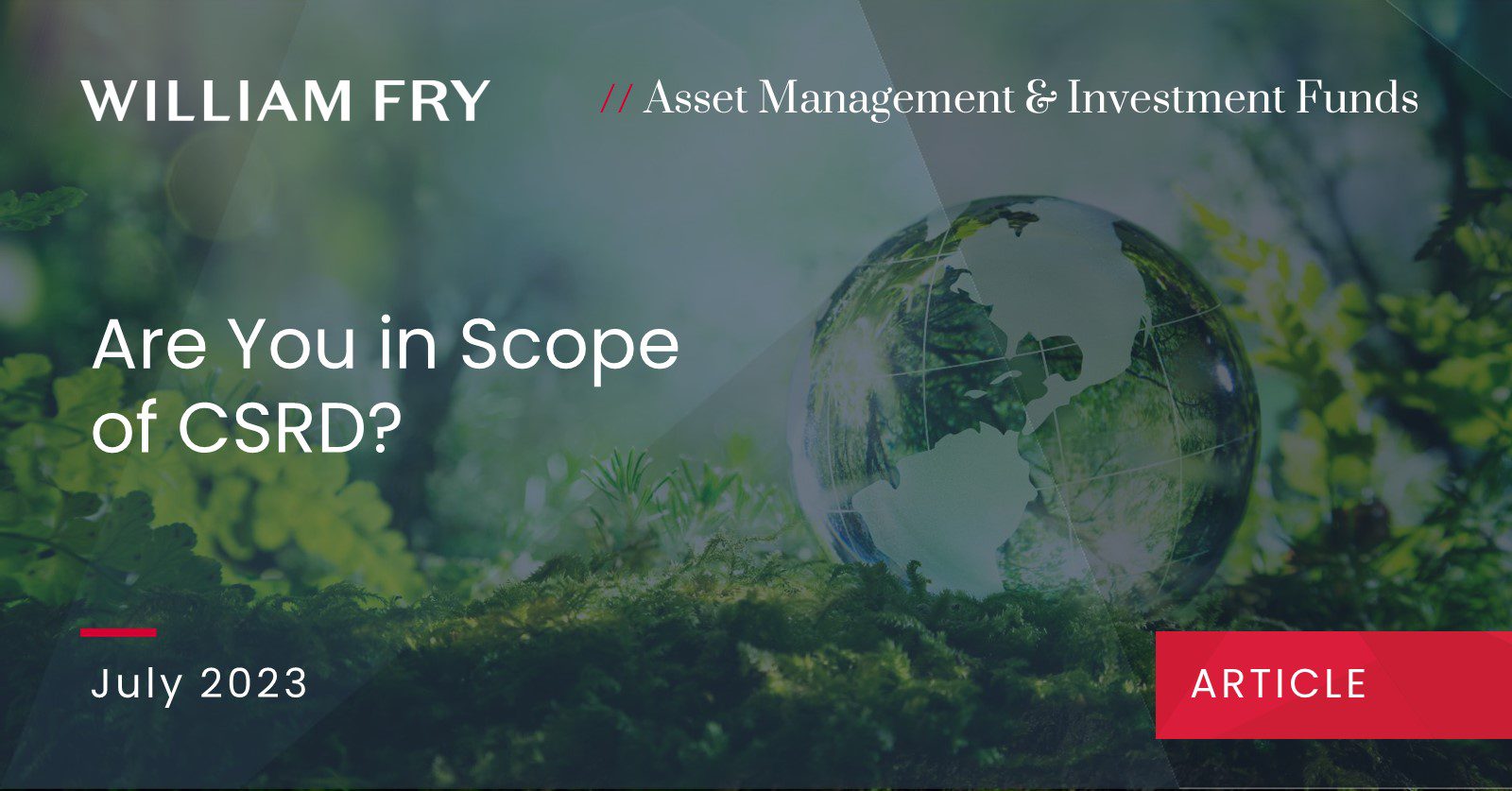The Commission consultation on CSRD Level 2 measures, detailing the sustainability reporting standards for in-scope companies, closed on 7 July 2023.
Level 2 will be finalised in the coming months, ahead of its first application on 1 January 2024 for companies subject to the previous EU sustainability reporting regime under the Non-Financial Report Directive.
CSRD compliance plans are advancing however, a fundamental first step is determining the scope of these obligations. A potentially challenging task requiring careful consideration given the expansive scope of CSRD and the complex nature of the governing legislative provisions.
Summarised below are the key categories of companies in scope of the CSRD, along with the thresholds, possible exemptions, and relevant deadlines for reporting using the Level 2 standards. CSRD is principally applicable to limited liability companies although there are some exceptions to this rule (e.g., for credit institutions and insurers). A company must exceed or cease to exceed the thresholds below on two consecutive balance sheet dates before it will be taken to have exceeded/not exceeded the relevant threshold.
Category 1: Large EU listed (EU/non-EU) companies and (EU/non-EU) parents of a large group
From 1 January 2025 (f/y 2024), these companies must publish CSRD sustainability reports in the management report.
- Threshold: the threshold for this category is met if a company has more than 500 employees and either:
- exceeds two of the thresholds for large companies of €40m net turnover; €20m balance sheet total, 250 employees; or
- exceeds, on a consolidated basis (including EU and non-EU subsidiaries), two of the thresholds for large groups of €40m net turnover, €20m balance sheet total, 250 employees.
Category 2: Large EU companies (not EU listed and with <500 employees)
From 1 January 2026 (f/y 2025), these companies must publish CSRD sustainability reports in the management report.
- Threshold: the threshold for this category is met if a company exceeds two out of the thresholds of €40m net turnover; €20m balance sheet total, 250 employees.
- Exemptions:
- UCITS and AIFs are specifically exempt
- A large EU subsidiary of an EU parent (which is not a large and EU listed subsidiary) is exempt if the subsidiary, along with its subsidiaries (if any), are included in the CSRD consolidated sustainability report of its EU parent, subject to conditions including that the subsidiary’s management report links to the consolidated sustainability report.
- A large EU subsidiary of a non-EU parent (which is not a large and EU listed subsidiary) is exempt if the subsidiary, along with its subsidiaries (if any), are included in the CSRD (or equivalent non-EU) consolidated sustainability report of its non-EU parent. CSRD provides for the adoption of equivalence decisions in respect of non-EU standards. This exemption is subject to the publication of the consolidated sustainability report and assurance opinion in accordance with CSRD rules and the inclusion of disclosures required by the Taxonomy Regulation, either in the consolidated sustainability report or the management report of the subsidiary.
- Until 6 January 2030, a large EU subsidiary (which is not a large and EU listed subsidiary) of a non-EU parent may publish a consolidated sustainability report covering all large or EU listed EU subsidiaries of the non-EU parent, including the required disclosures under the Taxonomy Regulation for such subsidiaries, provided the subsidiary is one of the parent’s EU subsidiaries that generated the greatest turnover in the EU in at least one of the preceding five financial years (on a consolidated basis, if applicable).
Category 3: Large/SME EU listed (EU and non-EU) companies (with <500 employees)
These companies must publish CSRD sustainability reports in the management report from 1 January 2026 (f/y2025) if large and EU listed (see thresholds in Category 2 above for large companies) or 1 January 2027 (f/y 2026) if EU listed SME.
- Threshold: the threshold for this category is met if a company is listed on an EU regulated market and it is not a micro company. A company is a micro company if it does not exceed at least two of the criteria of €700k net turnover, €350k balance sheet total, and 10 employees
- Exemptions:
- UCITS and AIFs are specifically exempt
- Until 1 January 2028, EU listed SMEs can comply or explain non-compliance with CSRD and thereafter, can comply with limited CSRD sustainability reporting standards currently under development and due to issue by 30 June 2024
- An EU listed subsidiary of an EU parent (which is not a large and EU listed subsidiary) is exempt if the subsidiary, along with its subsidiaries (if any), are included in the CSRD consolidated sustainability report of its EU parent, subject to conditions including that the subsidiary’s management report links to the consolidated sustainability report.
- An EU listed subsidiary of a non-EU parent (which is not a large and EU listed subsidiary) is exempt if the subsidiary, along with its subsidiaries (if any), are included in the CSRD (or equivalent non-EU) consolidated sustainability report its non-EU parent. CSRD provides for the adoption of equivalence decisions in respect of non-EU standards. This exemption is subject to the publication of the consolidated sustainability report and assurance opinion in accordance with CSRD rules and the inclusion of disclosures required by the Taxonomy Regulation, either in the consolidated sustainability report or the management report of the subsidiary.
Category 4: EU parents of large groups (not EU listed and with <500 employees)
From 1 January 2026 (f/y 2025), these companies must publish CSRD consolidated sustainability reports in the consolidated management report.
- Threshold: the threshold for this category is met if a company exceeds, on a consolidated basis (including EU and non-EU subsidiaries), two out of the three criteria of €40m net turnover, €20m balance sheet total, 250 employees
- Exemptions:
- An EU parent of a large group, which is a subsidiary, is exempt if the EU parent, along with its subsidiaries, are included in the CSRD consolidated sustainability reporting of another.
- An EU parent of a large group (which is not a large and EU listed subsidiary) which is a subsidiary of a non-EU parent, is exempt if the parent, along with its subsidiaries, are included in the CSRD (or equivalent non-EU) consolidated sustainability reporting of the non-EU parent. This exemption is subject to the publication of the consolidated sustainability report and assurance opinion in accordance with CSRD rules and the inclusion of disclosures required by the Taxonomy Regulation, either in the consolidated sustainability report or the management report of the EU parent.
- Until 6 January 2030, a large or EU listed EU subsidiary (which is not a large and listed EU subsidiary) of a non-EU parent may publish a consolidated sustainability report covering all large or EU listed EU subsidiaries of the non-EU parent, including the required disclosures under the Taxonomy Regulation for such subsidiaries, provided the subsidiary is one of the parent’s EU subsidiaries that generated the greatest turnover in the EU in at least one of the preceding five financial years (on a consolidated basis if applicable).
Category 5: Ultimate non-EU parents (not EU listed and with <500 employees) of one or more large or EU listed subsidiaries
From 1 January 2019 (f/y 2028), these companies must publish CSRD sustainability reports at the group level of the ultimate non-EU parent in accordance with CSRD reporting standards for non-EU entities to be adopted by 30 June 2024 or CSRD (or equivalent non-EU) consolidated sustainability reporting standards.
- Threshold: the threshold for this category is met if the ultimate non-EU parent has net turnover in the EU >€150m for each of the last two financial years and the subsidiaries meet the threshold for either large companies or EU listed companies (see categories 2 and 3 above for large and EU listed thresholds)
- Exemptions: if the information is not available to comply, the subsidiary must request all information to allow it comply with its obligations under categories 1- 3 above. If that information is not provided, the subsidiary may publish, alongside its CSRD sustainability report, a statement confirming the information that was not made available by the ultimate non-EU parent.
Category 6: Non-EU entities with EU branches and no large or EU listed subsidiaries
From 1 January 2029 (f/y 2028), these companies must publish CSRD sustainability reports at the group level or, if not part of a group, at the individual level of the non-EU entity in accordance with the CSRD reporting standards for non-EU entities to be adopted by 30 June 2024 or CSRD (or equivalent non-EU) consolidated sustainability reporting standards.
- Threshold: the threshold for this category is met if the EU branch had net turnover >€40m in the preceding financial year and the non-EU entity had net turnover in the EU >€150m for each of the last two financial years.
- Exemptions: if the information is not available to comply, the branch must request all information to allow it comply with obligations under categories 1 -3 above. If that information is not provided, the branch may publish, alongside its CSRD sustainability report, a statement confirming the information that was not made available by the non-EU entity.
Contact Us
If you have any queries on the issues discussed in this article, please get in touch with the key contacts, any member of the Asset Management & Investment Funds team or your usual William Fry contact.



